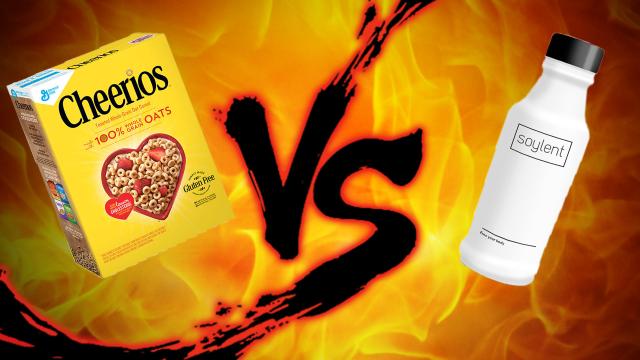While there are many quick breakfasts – buttered toast, granola bar, banana – cereal reigns supreme. But a new contender has climbed the ranks: Soylent, the nutrient slurry marketed to busy Millennials. Both are convenient, but neither is very natural. Which is a better option on a rushed morning?
The Contenders
A bowl of Cheerios: Normcore cereal. Processed oats fortified with 10-25% of most essential nutrients, plus 1 gram of sugar. Made for little hands. Cheerios are the default cereal in the US where they are the most popular brand. In recent years, they have become widely available in Australian supermarkets too.
A bottle of Soylent: SlimFast for nerds. Soy milk fortified with 20% of your recommended daily intake of every essential nutrient, plus 9 grams of sugar. Soylent is the best-in-class meal replacement product, and its marketing flaunts its science-experiment vibe.
[referenced url=”https://www.lifehacker.com.au/2016/08/five-things-we-learned-on-an-all-soylent-diet/” thumb=”https://www.lifehacker.com.au/wp-content/uploads/sites/4/2016/08/SAM_3147-2-410×231.jpg” title=”Five Things We Learned On An All-Soylent Diet” excerpt=”Last week, myself and Kotaku editor Mark Serrels ate nothing but bottled Aussielent; a liquid substance that contains all the nutrients and minerals needed to sustain life. That meant no solid meals, no snacks and — horrifyingly — no coffee or porridge for a whole week. At Lifehacker, we’re all about the takeaway message, so here are five things we each learned during the challenge…”]
Cheerios: As Real as Fake Food Gets
Cheerios were invented during World War II. The original variety came out in 1941, followed by Honey Nut Cheerios (the most popular variety, thanks to 9 grams of sugar) in 1979.
Cheerios feel natural because you know they have less sugar than pretty much everything but corn flakes and wonky adult cereals. General Mills pushes the health-food narrative, claiming Cheerios reduces cholesterol, which got it in trouble with the FDA in 2009.
Plain Cheerios are made of whole grains, low in sugar and free of GMOs, a relatively healthy option among cereals. Bu they’re still a processed starch, with vitamins added. Food writer Michael Pollan says, “Few, if any, health-savvy breakfast-eating people would make Cheerios a frequent choice.”
Still, it’s not terrible for you, and it’s extremely convenient: The only prep work is throwing it into a bowl along with some milk. Eating time is pretty quick, but you do need to remain stationary. And including the milk, it costs under 60 cents a bowl.
Soylent: Convenience at a Cost
The name, packaging, and origin story of Soylent seem calculated to embarrass you for drinking this generic food replacement in public. Which is a shame, because public consumption is the best thing this drink has going for it.
While Soylent is marketed as a supplement to a diet of actual food, it’s calculated such that it could, theoretically, replace all your meals. Each bottle contains one fifth of all your daily required nutrients. While it makes for an inadequate and depressing dinner, it’s well-suited to breakfast, especially on the go. It’s about the size of a water bottle, and just as easy to drink during your commute.
The taste is pretty great, so long as you’re cool with soy milk. That’s basically what this is, in its chemical way. It’s not organic, it has as much sugar as Honey Nut Cheerios, and it contains GMOs and natural and artificial flavours. So even measured against processed grains stuffed with vitamins, this isn’t hippie food. (The five other flavour varieties have the same sugar content, and three include caffeine.)
Most importantly, you pay quite a lot for that convenience: the Aussie version costs a whopping $5 per bottle or $49.90 for a case of 12. It’s still cheaper than most cafe breakfasts, but if you have the time to eat at home, Soylent is a pretty hefty choice.
Verdict: Cheerios for Your Good Days, Soylent for Your Bad Days
Unless you’ve optimised your life to the second, Soylent just isn’t worth the five minutes you save by not eating a bowl of cereal, especially if you’re already spending some time with coffee or tea each morning.
But on those occasional mornings you’re really running behind, it’s nice to grab a bottle and head out the door, knowing you won’t pass out before lunchtime. The shame associated with drinking out of that science-lab bottle will feel like your punishment for failing to make time for a proper breakfast. As Cookie Monster sang, Soylent is a sometimes food.

Comments
2 responses to “Breakfast Showdown: Soylent Vs Cheerios”
I don’t consume Soylent, and never will, but it is hands down the best choice for a quick intake of nutrients in htis instance. Cereal is horrendous.
We need to look at food more as a fuel source than something that needs to be %100 delicious.
Human optimisation performance requires quality macros. Not something you’ll find in Cheerios.
Unless it clearly states “people” on the ingredients I’m not touching Soylent